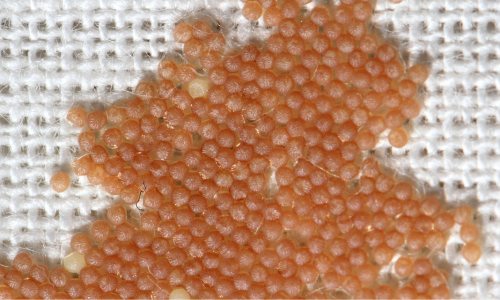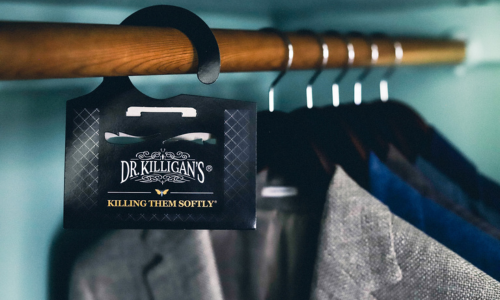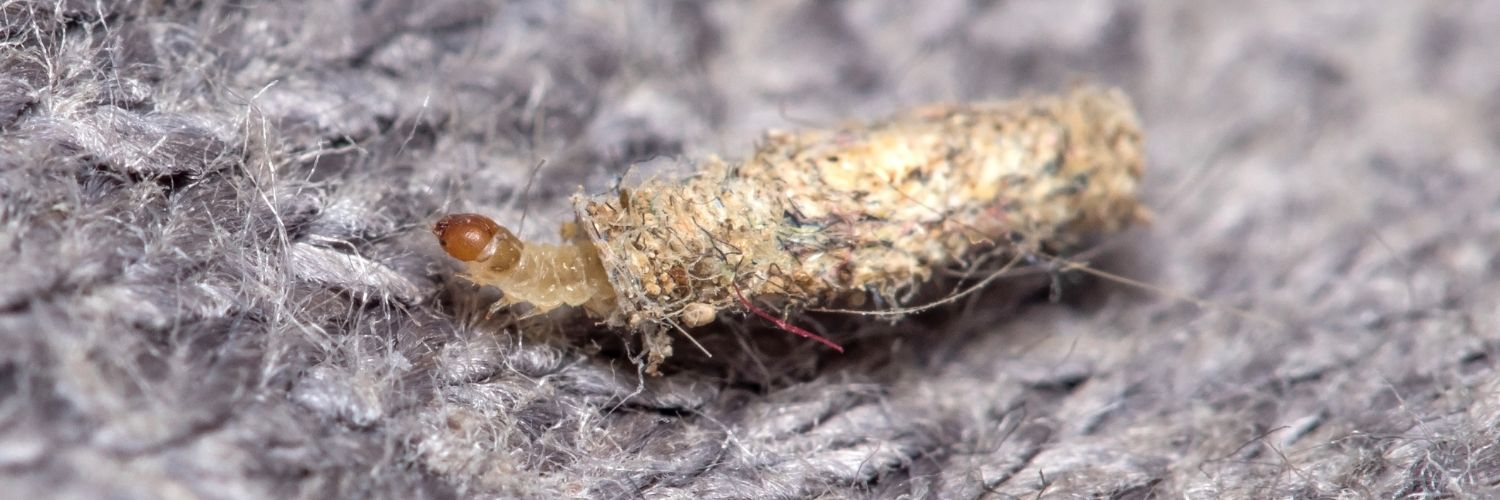When you have a clothing moth infestation, it may feel that they “suddenly appeared." It feels sudden because their arrival into your home was so very quiet and quite sneaky. How could you have possibly noticed that tiny cluster of creamy-colored nearly-invisible eggs on the fold of your cashmere sweater, which had been in your attic all summer? How would a naked eye have ever seen those few pinhead-sized eggs on the cuff of your silk blouse that you’d purchased from a consignment shop? How were you to know that that wool blanket that you’d been storing in your garage had nearly 40 yellow-colored eggs tucked into its seam?
>>> Shop Dr. Killigan's Premium Clothing Moth Traps now
In your home, clothing moth infestations generally begin with the egg. If you see an adult moth flying haphazardly through your home, you know to shoo it away or squish it with a shoe. But when an egg makes its way into your home, you are likely oblivious.
Clothing moths, my friends, are on the rise. They will gladly wreak havoc on your wardrobe and on your life. These winged pernicious fiends are not just a nuisance, but can be a costly problem. Arm yourself with knowledge about where clothing moths come from and prevent them from infiltrating your precious wardrobe, bringing ruin to your fine threads, and vexing your day to day life.
What do clothing moths eat?

The larvae of the two most common types of moths that eat clothes—the webbing clothes moth (Tineola bisselliella) and the case-bearing clothes moth (Tinea pellionella)—feed on items that contain keratin, a fibrous protein that they can easily digest. These items include cashmere, wool, fur, silk, feathers, felt and more. Pet hair and human hair are also attractants, as they are keratin-rich.
They are also attracted to fibers that are soiled with sweat, food or other organic matter. Because clothing moths don’t drink water, they need to get moisture from the clothes they eat. Human perspiration and bodily fluids, left on clothing, provide this moisture.
Clothing moths may find keratin in wool blankets, leather purses, felt-lined books, all goose down feather pillows, silk bedding, cashmere scarfs, antique natural-fiber teddy bears, soiled clothing and animal-hide rugs. They may also obtain it through accumulated pet hair in ductwork (or hard-to-reach areas) or your deer taxidermy.
Where do these moths come from?
There are six places that your clothing moth infestation may have come from:
- Used clothes, specifically those made of cashmere, wool, fur, silk, feathers, felt and leather. These can be from a consignment store, a thrift store, a garage sale or may be hand-me-downs.
- Dirty unattended clothes, specifically those stained with sweat, food or other organic matter.
- Used furniture, specifically if it is upholstered and contains wool, feathers or horsehair. The infestation could be on the outside or the inside of this upholstery.
- Stored items in your garage, your shed or your attic, specifically if those locations are warm, dark, humid and undisturbed and if the stored items are not in airtight containers or vacuum-sealed bags.
- Vents and Ducts, where the larvae may be feeding on lint, human hair, shed pet hair and other bits of debris.
- Bird nests (or animal carcasses), which would be present in your attic, chimney or wall cavity. Here, the larvae feed on the nesting materials, and the fur and skin of animal carcasses.
Why didn’t I know that I’d brought clothing moths into my home?
Clothing moth eggs and larvae often go undetected. Because their presence is undiscovered, they can easily slip into your home and begin their cycles of destruction.

You were likely unaware of their presence because of these four reasons:
- Their eggs are extremely small, measuring about 0.5 millimeters. For comparison, a sharp pencil point is about 1 millimeter.
- Their larvae, freshly hatched, are only a few millimeters long (though they soon grow to about 1-1.5 cm long).
- The eggs were dormant until they crossed your threshold. Once they enter an environment (like a home) that is warm, dark, and humid, they will hatch.
- The eggs, even if visible, are inconspicuous, having been laid in the crevices, folds or seams of clothing (such as the cuffs or collars of clothes) or other items.
How do I get rid of clothing moths?
Clothing moths have been around for a very long time. Here are five-quick-tips for getting rid of them. If you find that you have an infestation on your hands, you’ll need to understand how to effectively get rid of clothing moths.

- Clearly identify the winged pest. Ensure that it is not a pantry moth (which does not eat clothing) or a carpet beetle (which does).
- Launder, dry-clean, freeze or discard infested items and susceptible articles.
- Vacuum floors, carpets, and inside heating vents effectively. This will remove larvae as well as hair and lint.
- Vacuum along and beneath edges of carpets, along baseboards, underneath furniture and stored items, and inside closets and quiet, dark areas where clothes moths (as well as carpet beetles) prefer to feed.
- Spray Six Feet Under on baseboards, on walls, in corners, and on shelves - anywhere where the adult clothing moths may have laid eggs. This non-toxic spray will ensure the death of any eggs or larvae.
- Place Clothing Moth Traps. Traps are invaluable and necessary to both alert you to infestations (before they get out of hand) and to help quelch current infestations. Male clothing moths will be lured in by the powerful pheromones (and then get stuck in the stickiest glue). An end to male clothing moths equals the end of a moth’s mating cycle. Note: Do not use mothballs.










